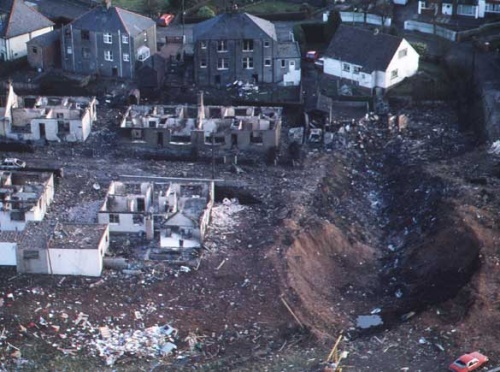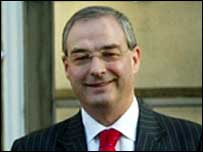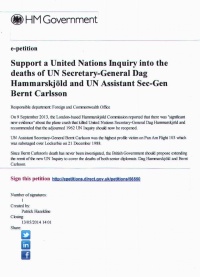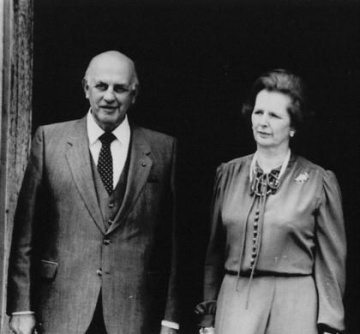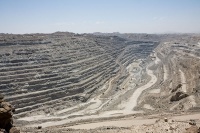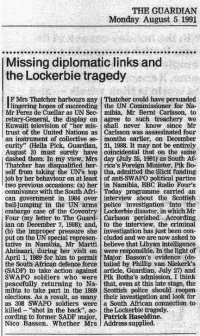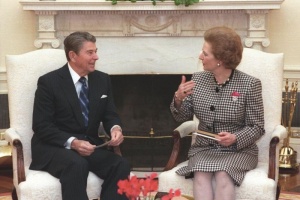Difference between revisions of "Pan Am Flight 103"
(Blackballing Patrick Haseldine) |
(→Thatcher visits Namibia: removing umlaut from image) |
||
| Line 136: | Line 136: | ||
===Thatcher visits Namibia=== | ===Thatcher visits Namibia=== | ||
| − | [[File: | + | [[File:Rossing_Uranium_Mine.jpg|200px|thumb|right|[[Rössing Uranium Mine]] ]] |
At the end of March 1989, [[Margaret Thatcher]] and the rising star in Conservative Research Department, [[David Cameron]], visited apartheid South Africa.<ref>[http://www.independent.co.uk/news/uk/politics/revealed-camerons-freebie-to-apartheid-south-africa-1674367.html "Cameron's freebie to apartheid South Africa"]</ref> The past and future British Prime Ministers made a point of visiting the [[Rössing Uranium Mine]] in Namibia (illegally occupied by apartheid South Africa in defiance of UN Security Council Resolution 435). In 1989, the Rössing mine was jointly owned by Rio Tinto Group and the Iranian Government, and was supplying uranium to develop Iran’s nuclear programme. Mrs Thatcher was so impressed with the [[Rössing Uranium Mine#Margaret Thatcher pays a visit|Rössing Uranium Mine]] that she declared it made her "proud to be British", a sentiment echoed by David Cameron.<ref>[http://www.radiobridge.net/www/nam/rossing.html "Rössing Uranium Mine"]</ref> | At the end of March 1989, [[Margaret Thatcher]] and the rising star in Conservative Research Department, [[David Cameron]], visited apartheid South Africa.<ref>[http://www.independent.co.uk/news/uk/politics/revealed-camerons-freebie-to-apartheid-south-africa-1674367.html "Cameron's freebie to apartheid South Africa"]</ref> The past and future British Prime Ministers made a point of visiting the [[Rössing Uranium Mine]] in Namibia (illegally occupied by apartheid South Africa in defiance of UN Security Council Resolution 435). In 1989, the Rössing mine was jointly owned by Rio Tinto Group and the Iranian Government, and was supplying uranium to develop Iran’s nuclear programme. Mrs Thatcher was so impressed with the [[Rössing Uranium Mine#Margaret Thatcher pays a visit|Rössing Uranium Mine]] that she declared it made her "proud to be British", a sentiment echoed by David Cameron.<ref>[http://www.radiobridge.net/www/nam/rossing.html "Rössing Uranium Mine"]</ref> | ||
Revision as of 17:01, 17 January 2014
| A synthesis page at The How, Why and Who of Pan Am Flight 103 summarises the material in this page and other related pages.. |
On 21 December 1988 Pan Am Flight 103, a Boeing 747-121 named "Clipper Maid of the Seas", was on a scheduled transatlantic flight from London Heathrow Airport to New York's John F. Kennedy International Airport when there was an explosion on board. The aircraft broke up over the Scottish town of Lockerbie (Map), killing all 243 passengers and 16 crew members. Eleven people in Lockerbie were killed by large sections of the plane which fell in and around the town, bringing total fatalities to 270.
Thirteen years later, on 31 January 2001, Libyan citizen Abdelbaset Ali Mohmed Al Megrahi was convicted of involvement in the bombing and sentenced to life imprisonment in Scotland. His co-defendant, Lamin Khalifah Fhimah, was unanimously acquitted. Megrahi's appeal against his conviction in January 2001 was refused on 14 March 2002 by a panel of five Scottish judges at Camp Zeist in the Netherlands.[1]
In June 2007, Megrahi was granted leave for a second appeal against his conviction, on the basis of evidence that a miscarriage of justice could have occurred. [2] His appeal to the Court of Criminal Appeal was abandoned by al-Megrahi in August 2009, just two days before the Scottish Government released him on compassionate grounds to return to Libya. The stated grounds for release were that he was suffering from terminal prostate cancer and was likely to die within three months.
Contents
Official Narrative
- Full article: Lockerbie Official Narrative
- Full article: Lockerbie Official Narrative
In August 2001, Scottish Lord Advocate Colin Boyd presented what might be considered the definite statement of the Lockerbie Official Narrative at a conference of the International Society for the Reform of Criminal Law (ISRCL):[3] While admitting that "Politics and diplomacy were necessarily interwoven with this case from the start", there is no mention of Bernt Carlsson, UN Commissioner for Namibia, and the evidence presented at the trial is presented as the unvarnished truth. Libyan Abdelbaset Ali Mohmed Al Megrahi, head of security for Libyan Arab Airlines, was determined at the trial to be a member of the Libyan Intelligence Services and of being guilty of the bombing. The narrative is predictably self-congratulatory: "In conclusion, it seems to me to be absolutely right that the investigation of crime and the prosecutorial decisions which flow from that investigation must be taken independently of political influence... Political and diplomatic action secured the trial. The investigation of the case and the prosecution of the trial were driven by the evidence."
Geopolitical Background
At the time of the attack:
- UK-US relations with Libya were icy over alleged Libyan sponsorship of terrorism and its stubborn refusal to 'see things the West's way'.
- UK-US relations with Iran were slated for improvement following the cessation of the Iran Iraq war in which both sides had been armed by the West.
- On 3 July 1988 Iran Air Flight 655, a civilian Airbus A300 airliner en-route from Bandar Abbas, Iran to Dubai, UAE was brought down by a missile fired by the US Navy guided missile cruiser USS Vincennes, with the loss of 290 lives. The US government claimed that the Airliner had been mistaken for an attacking F14 Tomcat fighter.
The Investigation
The people and organisations involved
- Vincent Cannistraro - CIA task force officer in the brutal 1980s Iran-Contra campaign. Deployed a training manual of invasion and killing of Nicaraguan citizens and officials. Wrote "the anatomy of a lie" to cover up US government involvement in Nicaragua. In 1986 was commissioned by the US President to "Destabilize Libya and destroy the Gaddafi regime". Secretly worked to arm the Afghanistan Mujahadeen and Osama Bin Laden. His chief Admiral Poindexter chaired a top-level meeting - to which Cannistraro had access - to discuss the manufacture of evidence to destabilize the government of Yemen. He was head of the CIA Lockerbie team, but did not attend the trial to give evidence.
The Trial
Geopolitical Background
- UK-US relations with Libya were being 'normalised' following Libya's agreement to extradite al-Megrahi for trial and its abandonment of its allegedly belligerent stance over previously core issues of policy on trade, oil and support for groups antagonistic to Western interests. The accommodation resulted in the lifting of UN trade sanctions against Libya which had progressively paralyzed its economy over the preceding decade.
- UK-US relations with Iran were close to all-time lows and deteriorating over the usual issues of Iranian refusal to 'see things the West's way'
Personalities central to the prosecution's case
- Tony Gauci - The crown's star witness, a Maltese shopkeeper, reportedly paid a large amount by the CIA[4]
- Thomas Thurman - FBI Laboratory 'scientist'
- Alan Feraday - Former head of the forensic laboratory at Royal Armaments Research and Development Establishment (RARDE) at Fort Halstead.
- Dr Thomas Hayes - Over the 1970s and early 1980s progressed to head the RARDE forensic laboratory. His testimony was central to the Lockerbie verdict. Yet he and two colleagues conspired to with-hold evidence from the 1974 alleged IRA Maguire Seven trial which would have indicated innocence. The Maguires were freed on appeal after fifteen years in jail. This matter was exposed in the Lockerbie trial, but the judges trusted Hayes' word implicitly.
Evidence withheld or not available at the time of the trial
- Former CIA agent, Robert Baer, CIA Middle Eastern specialist, worked on the early stages of the investigation. He has repeatedly claimed that, in 1989, there was "Grade A intelligence" held by America to prove that Iran requested and paid for the Lockerbie bombing. If Baer is correct, then the bomb timer fragment which pointed to Libya must have been planted.
- Lord Peter Fraser, Scotland's Chief Law Officer during the investigation and indictments, claimed in 1991 that witnesses would "prove the case beyond reasonable doubt." In 2005 he admitted to journalists that his chief witness Gauci was highly unreliable. Then in 2008, when questioned by a Times journalist, Fraser indicated suspicions that key evidence might have been planted with the knowledge of the CIA.
- Shukri Ghanem, Libyan Prime Minister 2003 - 2006, has said, on at least two occasions in radio and television interviews, that Libya was not responsible and it paid the $2.7 billion compensation with great reluctance and only "to buy peace and move forward."
- The alleged bomb timer fragment: Was it planted to frame Libya for the crime? The fragment's label had been altered by unknown persons. And its finding and examination by Dr Thomas Hayes proved highly suspicious. A series of scientific tests in 2009 have proved that its survival two centimetres from the centre of a high explosive fireball was impossible.[5]
Post-Trial developments
Cameron's Report on Forensic Evidence
- Full article: Cameron's Report on Lockerbie Forensic Evidence
- Full article: Cameron's Report on Lockerbie Forensic Evidence
At the beginning of 2003, former South African president Nelson Mandela asked the Western Christian churches to intervene in what he termed "a clear miscarriage of justice", referring to the conviction of Megrahi at Camp Zeist. In July that year, the Moderator of the General Assembly of the Church of Scotland, Rt Rev Professor Iain Torrance, took up the challenge and appointed the Church of Scotland's leading scientist Dr John Urquhart Cameron to conduct a scientific examination of all the forensic evidence which had convicted Megrahi. As a result, Cameron produced a damning report on the conduct of the forensic experts and on the evidence presented to the trial.[6]
Statement by UN Observer at the Trial
On 23 August 2003, Dr Hans Koechler, the United Nations Observer at the Lockerbie trial in the Netherlands (2000-2002), released a "Statement on the agreement between the United States, the United Kingdom and the Libyan Jamahiriya on the remaining issues relating to the fulfilment of all Security Council resolutions resulting from the bombing of Pan Am Flight 103 over Lockerbie." The Statement concluded:
- "17. The chapter of the Lockerbie investigation can only be closed when the full truth will have been established and when the question will have been satisfactorily answered why only a lone individual has been sentenced in a case that relates to a terrorist crime the commission of which required a vast and sophisticated operational network (most likely involving more than one country and/or terrorist organisation) and huge financial resources. An ambiguous declaration of "state responsibility" such as the one deposited with the UN Security Council does in no way answer the urgent and legitimate question as to personal criminal responsibility of individuals other than Mr Al-Megrahi (and eventually also from other countries) for the Lockerbie crime. A political deal such as the one concluded last week between the US, UK and Libya linking individual compensation with the lifting of multilateral and subsequently unilateral sanctions does not advance the cause of justice in the present case, but is part of the politics of national interest of the countries involved in the present dispute. The intelligence cooperation established between the three countries since September 11, 2001, in the area of counter-terrorism must not come at the expense of the search for truth in the Lockerbie case. The doubts and misgivings about the Lockerbie trial in the Netherlands will only disappear when a full investigation of the crime by an independent commission will have been undertaken. Up to this moment the undersigned will maintain his doubts about the Lockerbie verdict and will consider the judgment concerning Mr Al-Megrahi – on the basis of an Indictment that was substantially modified in the course of the trial and altered by the judges as part of the Verdict – as a miscarriage of justice."[7]
Scottish Criminal Cases Review Commission
On 23 September 2003 lawyers acting for Abdelbaset al-Megrahi applied to the Scottish Criminal Cases Review Commission (SCCRC) for a review of the case (both sentence and conviction), arguing that there had been a miscarriage of justice. On 1 November 2006, Megrahi was reported to have dropped his demand for the new appeal to be held at Camp Zeist.[8] In an interview with The Scotsman newspaper of 31 January 2006, retired Scottish Judge Lord MacLean – one of the three who convicted Megrahi in 2001 – said he believed the SCCRC would return the case for a further appeal against conviction:
- "They can't be working for two years without producing something with which to go to the court."
MacLean added that any new appeal would indicate the flexibility of Scots law, rather than a weakness:
- "It might even be the strength of the system – it is capable of looking at itself subsequently and determining a ground for appeal."
In January 2007, the SCCRC announced that it would issue its decision on Megrahi's case by the end of June 2007.[9] On 9 June 2007 rumours of a possible prisoner swap deal involving Megrahi were strenuously denied by the then Prime Minister, Tony Blair.[10] Later in June, The Observer confirmed the imminence of the SCCRC ruling and reported:
- "Abdelbaset al-Megrahi never wavered in his denial of causing the Lockerbie disaster: now some Scottish legal experts say they believe him."[11]
On 28 June 2007, the SCCRC concluded its four-year review and, having uncovered evidence that a miscarriage of justice could have occurred, the commission granted Megrahi leave to appeal against his Lockerbie bombing conviction for a second time.[12]
In a statement dated 29 June 2007 Dr Hans Köchler, international observer at the Lockerbie trial, expressed his surprise at the SCCRC's narrow focus and apparent bias towards the judicial establishment:
- "In giving exoneration to the police, prosecutors and forensic staff, I think they show their lack of independence. No officials to be blamed, simply a Maltese shopkeeper."[13]
Reliability of Tony Gauci
In 2005, Maltese shopkeeper Tony Gauci was exposed as an unreliable witness by the man who in 1991 indicted Megrahi, former Scottish Lord Advocate Peter Fraser. In Fraser's words, Gauci was "an apple short of a picnic." And yet the judges trusted Gauci's contradictory and confused evidence, and ignored the fact that Gauci was on a promise of a multi-million dollar reward if Al-Megrahi was convicted. Michael Meacher, MP, also alleged bribery of the chief prosecution witness with the collusion of Strathclyde police and the US Authorities, though his blog post was later removed.[14]
Megrahi's release on compassionate grounds
On 20 August 2009, Megrahi's release was authorised by the Scottish Secretary of Justice, Kenny MacAskill under a 1993 Scottish statute enabling the release from prison of anyone deemed by competent medical authority to have three months or less to live.[15] The public were lead to believe that Megrahi had only 3 months to live.
Cable 08LONDON2673 (dated 2008-10-24) from the US Embassy London states however:
- "Megrahi was first diagnosed on 23 September at Inverclyde Royal Hospital, both the FCO and the Scottish Crown office have told us; the second diagnosis was on 10 October. The two diagnoses match: he has prostate cancer that has spread to his bones, the cancer has advanced rapidly, and it is inoperable and incurable. Megrahi could have as long as five years to live, but the average life expectancy of someone of his age with his condition is eighteen months to two years".[16]
Another leaked cable, 09TRIPOLI65 (dated 2009-01-28) from the US Embassy Tripoli reports:
- "The case of convicted Pan Am 103 bomber Abdelbaset al-Megrahi is arguably the regime’s most sensitive political subject, in part because it involves a firm timeline in the form of the ailing al-Megrahi’s approaching death. Through remarks by senior officials suggesting that al-Megrahi is innocent and a steady diet of publicity about his case, the regime has limited its room for political maneuver. U.K. Embassy interlocutors here are planning for a scenario in which the U.K.-Libya Prisoner Transfer Agreement is ratified in early March and the GOL makes application shortly thereafter for al-Megrahi’s transfer to Libya. The U.K. Embassy expects a sharply negative GOL reaction if al-Megrahi dies in prison or if the Scottish Executive and/or FCO oppose his transfer".[17]
Another cable stated that the UK feared action by Libya against British interests if Megrahi died in jail.[18]
Channel 4 news presenter, Jon Snow, wrote that the report of the Scottish Criminal Cases Review Commission "states that after the trial Tony Gauci was paid $2 million, and that brother Paul got $1 million reward money" that after the trial Tony Gauci was paid $2 million, and that brother Paul got $1 million reward money. If true, these would be completely dynamite revelations. Of course, they would have come out in the appeal that Megrahi’s release prevented happening. It is inconceivable that this Scottish Review Commission’s report would not have surfaced at such an appeal. Does this perhaps explain why he was eventually bundled so speedily out of the country?"[19]
In fact, Megrahi died in 20 May 2012, almost three years after his release was authorised.[20]
Alternative Possibilities
South African Apartheid Regime
President P W Botha ruled apartheid South Africa between 1978 and 1989 and was responsible for gross human rights violations, including all the violence that was sanctioned by the State Security Council (SSC), an executive organ of his apartheid regime. Such violence included using torture, abduction, arson and sabotage, and murdering those opposed to apartheid.[21] An SSC subcommittee, chaired by 'superspy' Major Craig Williamson, targeted anti-apartheid groups and individuals.[22]
From Chequers to Lockerbie
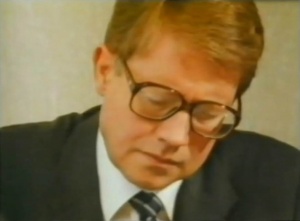
The distance by road from Chequers, the Prime Minister’s country residence in Buckinghamshire, to the site in Scotland of the Pan Am Flight 103 crash on 21 December 1988 is 310 miles. It took more than 4½ years for President P W Botha to complete his murderous journey from meeting Margaret Thatcher at Chequers on 2 June 1984 to the sabotage at Lockerbie.[23]
The full article "From Chequers to Lockerbie" by Patrick Haseldine can be read here.
Highest profile Pan Am Flight 103 victim
- Full article: Bernt Carlsson
- Full article: Bernt Carlsson
Newspaper reports quickly identified the highest profile Pan Am Flight 103 victim as Bernt Carlsson, due to attend a ceremony in New York the next day, at the United Nations granting independence to Namibia. However, after a brief spell of attention, this angle of the bombing was not pursued by commercially-controlled media.
E-petition to HMG
In November 2013, former diplomat Patrick Haseldine created this e-petition calling upon HM Government (Foreign and Commonwealth Office) to:
- "Support a United Nations Inquiry into the deaths of UN Secretary-General Dag Hammarskjöld and UN Assistant Secretary-General Bernt Carlsson"
- On 9 September 2013, the London-based Hammarskjöld Commission reported that there was "significant new evidence" about the plane crash that killed United Nations Secretary-General Dag Hammarskjöld and recommended that the adjourned 1962 UN Inquiry should now be reopened.
- UN Assistant Secretary-General Bernt Carlsson was the highest profile victim on Pan Am Flight 103 which was sabotaged over Lockerbie on 21 December 1988.
- Since Bernt Carlsson's death has never been investigated, the British Government should propose extending the remit of the new UN Inquiry to cover the deaths of both senior diplomats: Dag Hammarskjöld and Bernt Carlsson.
The e-petition is open for signature by UK citizens and residents from 13 November 2013 to 13 May 2014, and can be signed here.
Lockerbie cover-up
Within a few weeks of those December 1988 newspaper reports, Bernt Carlsson's name would hardly ever be mentioned again by the mainstream media in the Lockerbie context. Bernt Carlsson had effectively become a "nonperson" - whose death was never properly investigated - and the Lockerbie cover-up was beginning:[24]
Nelson Mandela accused
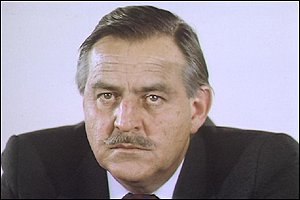
Three weeks after the Lockerbie disaster, the apartheid regime accused Nelson Mandela and the ANC of masterminding the sabotage of Pan Am Flight 103. This amazing accusation was made on 11 January 1989 by South African Foreign Minister Pik Botha who had travelled to Stockholm in Sweden with other foreign dignitaries – including UN Secretary-General Javier Pérez de Cuéllar – to attend the memorial service of United Nations Commissioner for Namibia, Bernt Carlsson, the highest profile victim of the 270 fatalities at Lockerbie.[25] Interviewed by Sue MacGregor on BBC Radio 4’s Today Programme, Pik Botha alleged that he and a 22-strong South African delegation, who were booked to fly from London to New York on 21 December 1988, had been targeted by the ANC. However, having been alerted to these ANC plans to kill him, Pik Botha said he managed to outsmart them by taking the earlier Pan Am Flight 101 from Heathrow to JFK, New York.[26] Pik Botha's claim to have been booked to travel on Pan Am Flight 103 was later shown to be false.[27]
President Botha quits
On 18 January 1989, President P W Botha was reported to have suffered a mild stroke which prevented him from attending a meeting with Namibian political leaders on 20 January 1989.[28] On 2 February 1989, P W Botha resigned as leader of the National Party (NP) anticipating his nominee – finance minister Barend du Plessis – would succeed him. Instead, the NP's parliamentary caucus selected as leader education minister F W de Klerk, who moved quickly to consolidate his position within the party. In March 1989, the NP elected de Klerk as state president but Botha refused to resign, saying in a television address that the constitution entitled him to remain in office until March 1990 and that he was even considering running for another five-year term. Following a series of acrimonious meetings in Cape Town, and five days after UN Security Council Resolution 435 was implemented in Namibia on 1 April 1989, Botha and de Klerk reached a compromise: Botha would retire after the parliamentary elections in September, allowing de Klerk to take over as president. However, P W Botha resigned from the state presidency abruptly on 14 August 1989 complaining that he had not been consulted by de Klerk over his scheduled visit to see president Kenneth Kaunda of Zambia: "The ANC is enjoying the protection of president Kaunda and is planning insurgency activities against South Africa from Lusaka," Botha declared on nationwide television. He said he had asked the cabinet what reason he should give the public for abruptly leaving office. "They replied I could use my health as an excuse. To this, I replied that I am not prepared to leave on a lie. It is evident to me that after all these years of my best efforts for the National Party and for the government of this country, as well as the security of our country, I am being ignored by ministers serving in my cabinet."[29]
Thatcher visits Namibia
At the end of March 1989, Margaret Thatcher and the rising star in Conservative Research Department, David Cameron, visited apartheid South Africa.[30] The past and future British Prime Ministers made a point of visiting the Rössing Uranium Mine in Namibia (illegally occupied by apartheid South Africa in defiance of UN Security Council Resolution 435). In 1989, the Rössing mine was jointly owned by Rio Tinto Group and the Iranian Government, and was supplying uranium to develop Iran’s nuclear programme. Mrs Thatcher was so impressed with the Rössing Uranium Mine that she declared it made her "proud to be British", a sentiment echoed by David Cameron.[31]
Pressure on UN's man
Extract from Patrick Haseldine's letter to The Guardian of August 5, 1991:
- Missing diplomatic links and the Lockerbie tragedy
- "On April 1, 1989 Mrs Thatcher put pressure on UN Special Representative in Namibia, Martti Ahtisaari, to permit the South African Defence Force (SADF) to take action against SWAPO soldiers who were peacefully returning to Namibia to vote in the 1989 independence elections. As a result, as many as 308 SWAPO soldiers were killed - shot in the back according to former SADF major Nico Basson.
- "Whether Mrs Thatcher could have persuaded UN Commissioner for Namibia, Bernt Carlsson, to agree to such treachery we shall never know since Mr Carlsson was assassinated four months earlier, on December 21, 1988.
- "It may not be entirely coincidental that on the same day (July 25, 1991) as South Africa's Foreign Minister, Pik Botha, admitted the illicit funding of anti-SWAPO political parties in Namibia, BBC Radio Four's Today Programme carried an interview about the Scottish police investigation into the Lockerbie disaster, in which Mr Carlsson perished. According to the interview, the criminal investigation has just been concluded and we are now asked to believe that Libyan intelligence were responsible.
- "In the light of Major Basson's evidence (detailed by Phillip van Niekerk's article, Guardian, July 27) and Pik Botha's admission, I think that, even at this late stage, the Scottish police should reopen their investigation and look for a South African connection to the Lockerbie tragedy.[32]
Secret nuclear deal
It has recently been reported that Margaret Thatcher and David Cameron concluded a secret nuclear deal with the apartheid regime during their visit to South Africa in 1989.[33]
Stateside silence
Ronald Reagan, the outgoing President, was still smarting after having his veto overridden in 1986 by the US Congress of the Comprehensive Anti-Apartheid Act which, inter alia, banned South African Airways from flying to the United States. Plus, according to Professor Francis Boyle's recent book, President Reagan had some old scores that he wanted to settle with Colonel Gaddafi.[34]
So, on 28 December 1988, when there was as yet no evidence of any country's culpability for the Lockerbie bombing and in one of the last acts of his Presidency, Ronald Reagan extended US sanctions against Libya and threatened renewed bombing raids on Tripoli and Benghazi. Vice-President George H W Bush had won the 1988 US presidential election easily defeating Democratic Party challenger Michael Dukakis (who would have branded P W Botha's apartheid South Africa a 'terrorist state'[35]) and was sworn in as US President on 20 January 1989.
Drawing upon his previous experience at the United Nations and as Director of the CIA, and maintaining his refusal to apologise for the US Navy's destruction of the Iranian Airbus in July 1988, President Bush Sr then arranged for Muammar Gaddafi to be 'fitted up' at the UN Security Council for the sabotage of Pan Am Flight 103. According to British investigative journalist Paul Foot: "In mid-March 1989, three months after Lockerbie, George Bush rang Margaret Thatcher to warn her to 'cool it' on the subject."[36]
British Blackout
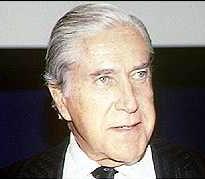
After years of sleuthing, Emeritus Professor of Lockerbie Studies Patrick Haseldine eventually identified British mining magnate, Observer newspaper owner and MI6 operative Tiny Rowland as the UK coordinator of the Lockerbie cover-up.[37]
Haseldine alleges that Tiny Rowland recruited Emeritus Professor of Scots Law Robert Black to organise the British Blackout and to frustrate all of Nelson Mandela’s plans for Lockerbie justice.
In January 1992, Mandela outlined his blueprint for the Lockerbie trial:
- If no extradition treaty exists between the countries concerned, the trial must be conducted in the country where the accused were arrested;
- The trial should be conducted in a neutral country by independent judges;
- The trial should be conducted at The Hague by an international court of justice.
Five years later, President Mandela emphasised at the Commonwealth Heads of Government Meeting (CHOGM) in Edinburgh that "no one nation should be complainant, prosecutor and judge" in the Lockerbie case.
By 1999, the so-called "architect of the Lockerbie trial" had managed to blackout the whole Mandela blueprint. Professor Black:
- ensured that the Lockerbie trial was not held in a neutral country. Instead, he arranged for the trial to be conducted from May 2000 to January 2001 at Camp Zeist, a former US Air Force base in the Netherlands which, for the duration of the trial, became British territory;
- decreed that Scotland’s Crown Office would be the ‘complainant’ at the trial;
- arranged for Scotland’s Lord Advocate Colin Boyd to be the ‘prosecutor’ at the trial; and,
- insisted that – instead of ‘independent judges’ at the trial – all four Judges (Lords Sutherland, Coulsfield, MacLean and Abernethy) had to be from Scotland.
Although one of the two accused Libyans was found not guilty of the Lockerbie bombing, Haseldine alleges it was thanks to Professor Black that the other Libyan, Abdelbaset al-Megrahi, was found guilty.[38]
Haseldine says:
.... so for the past 20 years, Professor Robert Black has been suppressing the truth about the Lockerbie disaster, thus delaying justice for the 270 victims of Pan Am Flight 103 and their relatives. Prof Black was supported in his attempt to blackout apartheid South Africa’s targeting of Bernt Carlsson on Pan Am Flight 103 by inter alia these assets of British intelligence:
John Ashton (Author, producer and researcher, see: The Maltese Double Cross[39]; the 2001 book "Cover-up of Convenience" by John Ashton and Ian Ferguson[40]; the 2012 book "Megrahi; You are my Jury" by John Ashton[41]; the 2012 article "Was Libya really behind it?" with John Ashton[42]; and a new book "Scotland’s Shame: Why Lockerbie Still Matters" that was published by Birlinn on 3 October 2013[43]);
Ian Ferguson (Author, journalist and researcher, see: The Lockerbie Trial.com website of Professor Black and Ian Ferguson; and the 2009 film Lockerbie Revisited researcher Ian Ferguson[44][45]);
Robert Forrester (Secretary of Justice for Megrahi campaign group[46]);
Professor Andrew Fulton (see: "Former MI6 spy joins Armor Group to hunt down new business"[47]);
Dr Alan George (Middle East academic, recruited by solicitors Eversheds to reinforce the defence of Megrahi's co-accused Lamin Khalifah Fhimah[48]);
Dr Morag Kerr (Deputy Secretary of Justice for Megrahi campaign group, see [49], her book "Adequately Explained by Stupidity? Lockerbie, Luggage and Lies" will be published on 21 December 2013 [50]); and,
Adam Larson (Associate of Dr Kerr and owner of The Lockerbie Divide website[51]);
Patrick Haseldine concludes: "It is high time that this 'Blackout over Lockerbie' was illuminated and dispelled."[52]
Blackballing Patrick Haseldine
On 14 January 2014, these three comments appeared on Professor Black's The Lockerbie Case blog in relation to an article by William Blum in the Foreign Policy Journal of 10 January 2014:[53]
1. pesceman said: So we know al-Megrahi was innocent. Of that there is no doubt. Why was the Heathrow break-in totally ignored from the very start - the Anti-Terrorism Police in the UK don't seem able to recall the event at all???? It is pretty obvious that the South African Civil Cooperation Bureau were wholly responsible and assisted in the cover up by UK Intelligence and UK Police.
2. Robert Black said: It is by no means obvious. And the notion that the CCB was responsible stems from Patrick Haseldine's fevered imagination. There is nothing whatever that counts as evidence to support it. No further comments giving credence to Mr Haseldine's ravings will be accepted on this blog.
3. Quincey Riddle aka Robert Forrester said: Dear Peaceman, I agree entirely with Robert Black vis-a-vis the South African theory. Mr Haseldine is frankly certifiably doolally and an extremely manipulative individual, whom I felt obliged to expel from JFM for his conduct. I would be careful too about laying too much store on the issue of the Heathrow break-in as being linked to Pan Am 103, maybe it was maybe it wasn't. In my view, the only significant factor here is that COPFS appears to have hidden a tree in a forest in terms of the evidence made available to the defence. That from my perspective is as reprehensible as the Gauci payments being denied to the court. Robert.
See also
On WikiSpooks
- The how, why and who of Pan Am Flight 103
- A MUST READ - File:The Framing of al-Megrahi.doc - An article by Gareth Pierce from the London Review of Books - September 2009.
- UN Report on the first Lockerbie case appeal Professor Hans Koechler Vienna 26 March 2002
- How Megrahi and Libya were framed for Lockerbie - Alexander Cockburn in "The First Post" July 2010
- Bomber, Bomber, Bomber - Steven Raeburn of "The Firm", a Scottish Lawyers Web Site
- The Lockerbie case and the corruption of justice - Dr Hans Koechler
- Release of the Lockerbie Prisoner - Dr Hans Koechler
- The Lockerbie case and the corruption of justice - Dr Hans Koechler
- The Syrian Connection - David Guyatt
- Lockerbie: Ayatollah's Vengeance Exacted by Botha's Regime - Patrick Haseldine
- Comments from Patrick Haseldine on Robert Black's Blog - 6 October 2009
External sites
- Highly Recommended - The Herald, Scotland - Lockerbie archive - A substantial Establishment-sceptic resource.
- Highly Recommended - - ohmynews - list of articles on the Lockerbie Bombing
- Scottish Law Reporter. Lockerbie pages
- Lockerbie - The evidence
- Flight From the Truth - The Guardian 27 June 2001
- Jim Swire's Web Site
- Facebook group: U.N. must investigate the targeting of Bernt Carlsson on Pan Am Flight 103
- Professor Robert Black's Blog
- Crown Fights to keep 48 pieces of evidence secret - Glasgow Herald 19 February 2010
- Questions remain over Lockerbie - Guardian letters 23 July 2010
- Lockerbie witness 'put up for reward'
- Lockerbie Bombing Case Faces U-Turn after Perjury Confession - Sofia News Agency 20 August 2007
- UN Claims Lockerbie Trial Was Rigged - Common Dreams 8 April 2001 from The Glasgow Herald
- WikiPedia - Pan Am Flight 103 page
Video
- Lockerbie Lies - A Youtube video featuring Professor Robert Black who was largely responsible for the setup of the Hague Trial and believes that Megrahi would be aquitted in any retrial.
- "The Lockerbie Bombing - Pan Am Flight 103" Al-Jazeera TV documentary featuring Professor Robert Black and Dr John Cameron.
References
- ↑ "UN monitor decries Lockerbie judgement"
- ↑ File:SCCRC-Lockerbie.pdf - SCCRC Leave to appeal decision press release - June 2007
- ↑ "The Lockerbie Trial" by Rt Hon Colin Boyd QC, Lord Advocate, Scotland
- ↑ http://www.heraldscotland.com/revealed-cia-offered-2m-to-lockerbie-witness-and-brother-1.866400
- ↑ The two key elements of al-Megrahi's conviction
- ↑ "Lockerbie: Mandela and Dr John Cameron's Report"
- ↑ "Statement by Hans Koechler, UN Observer at the Lockerbie Trial" 23 August 2003
- ↑ "Appeal can be held in Edinburgh"
- ↑ "SCCRC ruling by the end of June 2007"
- ↑ "PM says no deal over Megrahi"
- ↑ "Evidence that casts doubt on who brought down Flight 103"
- ↑ "SCCRC referral of Megrahi case"
- ↑ "Statement by Dr Hans Köchler"
- ↑ "Lockerbie: The Truth is finally coming out" - The now removed post by Michael Meacher MP on his blog, reposted on Robert Black's blog.
- ↑ "Lockerbie bomber released: Kenny MacAskill's full statement"
- ↑ "08LONDON2673: PAN AM 103 BOMBER HAS INCURABLE CANCER; LIBYANS"
- ↑ "09TRIPOLI65: PAN AM BOMBER AL-MEGRAHI: THE VIEW FROM TRIPOLI"
- ↑ "WikiLeaks cables: Lockerbie bomber freed after Gaddafi's 'thuggish' threats"
- ↑ "Bribery at the heart of Megrahi's Lockerbie conviction"
- ↑ "Lockerbie bomber Abdelbaset al-Megrahi dies in Tripoli", BBC
- ↑ "South African Truth and Reconciliation Commission"
- ↑ "Interview with SA 'superspy' Craig Williamson"
- ↑ "Botha 'linked to murder decisions'"
- ↑ "Lockerbie Cover-Upper Ian Ferguson"
- ↑ "Lockerbie: Bernt Carlsson's secret meeting in London"
- ↑ "ANC as the fall-guys for Lockerbie bombing" Patrick Haseldine's letter to The Guardian, 22 April 1992
- ↑ "Why the Lockerbie flight booking subterfuge, Mr Botha?"
- ↑ The New York Times 22 January 1989 "Botha suffers mild stroke"
- ↑ Botha Quits, Criticizes Successor
- ↑ "Cameron's freebie to apartheid South Africa"
- ↑ "Rössing Uranium Mine"
- ↑ "Missing diplomatic links and the Lockerbie tragedy"
- ↑ "How the US and UK 'lost' three nuclear weapons"
- ↑ "Destroying Libya and World Order: The Three-Decade U.S. Campaign to Terminate the Gaddafi Revolution"
- ↑ Dukakis Backers Agree Platform Will Call South Africa 'Terrorist'
- ↑ "Lockerbie: CIA 'fitted up' Gaddafi at the UN"
- ↑ "Tiny Rowland, Lonmin and Lockerbie"
- ↑ "Blackout of Mandela Blueprint for Lockerbie Justice"
- ↑ "Commentary on The Maltese Double Cross"
- ↑ "Cover-up of Convenience"
- ↑ "Megrahi: You are my Jury"
- ↑ "Was Libya really behind it?"
- ↑ "Scotland’s Shame: Why Lockerbie Still Matters"
- ↑ "Lockerbie Revisited"
- ↑ "Lockerbie Cover-Upper Ian Ferguson"
- ↑ "Robert Forrester Facebook page"
- ↑ "Former MI6 spy joins Armor Group to hunt down new business"
- ↑ "Alan George libel case
- ↑ "Dr Morag Kerr should drop all this cloak and dagger 'Rolfe' nonsense"
- ↑ "Adequately Explained by Stupidity? Lockerbie, Luggage and Lies"
- ↑ "The Lockerbie Divide"
- ↑ "Blackout over Lockerbie"
- ↑ "The Bombing of Pan Am Flight 103: Case closed?"


